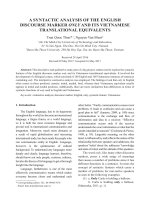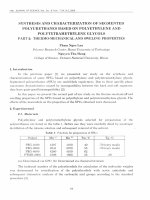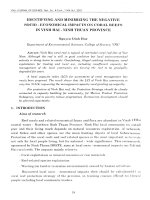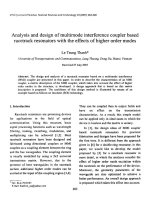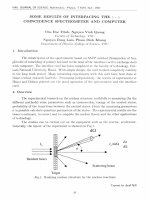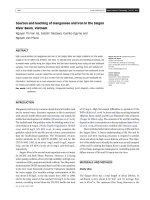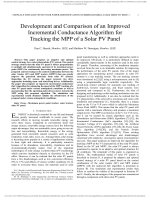DSpace at VNU: Notes and Correspondence On the consistency between dynamical and thermodynamic equations with prescribed vertical motion in an analytical tropical cyclone model
Bạn đang xem bản rút gọn của tài liệu. Xem và tải ngay bản đầy đủ của tài liệu tại đây (131.04 KB, 4 trang )
Quarterly Journal of the Royal Meteorological Society
Q. J. R. Meteorol. Soc. 136: 1927–1930, October 2010 Part A
Notes and Correspondence
On the consistency between dynamical and thermodynamic
equations with prescribed vertical motion in an analytical
tropical cyclone model
Chanh Q. Kieua * and Da-Lin Zhangb
a Weather
and Climate Research Laboratory, Hanoi College of Science, National University, Hanoi, Vietnam
of Atmospheric and Oceanic Science, University of Maryland, College Park, USA
*Correspondence to: Dr. Chanh Q. Kieu, Lab of Weather and Climate Research, Hanoi College of Science, Vietnam
National University, 334 Thanh Xuan, Hanoi, Vietnam 10000. E-mail:
b Department
In our earlier paper, we presented an analytical model for intensifying tropical
cyclones (TCs), in which the effects of all nonlinear terms in the horizontal
momentum equations are retained. This analytical model was obtained by
prescribing the time evolution of the vertical motion. In this paper, we demonstrate
that, with the prescribed vertical motion, the system of governing equations for
geophysical flows can be separated into two subsystems: one consisting of the
horizontal momentum and continuity equations, and the other including the vertical
momentum and thermodynamical equations. Results show that the analytical
solutions for the horizontal winds obtained from the first subsystem are consistent
with the mass field in the second subsystem, such as the thermal wind relationship
in TCs. Furthermore, we show that use of any functional form for the mean vertical
motion will not affect our previous major conclusions about the different growth
rates either between the secondary and primary circulations or between the inner
and outer regions in TCs. Copyright c 2010 Royal Meteorological Society
Key Words:
hurricane dynamics; rapid intensification; tropical cyclones
Received 26 August 2009; Revised 3 May 2010; Accepted 13 June 2010; Published online in Wiley Online Library
2 September 2010
Citation: Kieu CQ, Zhang D-L. 2010. On the consistency between dynamical and thermodynamic equations
with prescribed vertical motion in an analytical tropical cyclone model. Q. J. R. Meteorol. Soc. 136: 1927–1930.
DOI:10.1002/qj.671
1.
Introduction
Although the forecasts of tropical cyclone (TC) tracks have
achieved considerable progress, forecasting TC intensity
changes, particularly for rapidly developing TCs, is still
a challenging issue. This could be attributed partly to
the lack of understanding of the nonlinear feedback
processes involved in the genesis and subsequent more
rapid intensification of TCs. Theoretical models for TC
intensification used to be formulated from the perspective
of the secondary circulation (SC; e.g. Charney and Eliassen,
1964; Yanai, 1964). However, little is known about the
relationship between the growth of the SC and the intensity
Copyright c 2010 Royal Meteorological Society
and intensity changes of the primary circulation (PC), which
are often represented by the maximum surface winds, Vmax ,
and the minimum central pressure or the central pressure
drop, δPmin .
Recently, we developed an analytical model (Kieu and
Zhang, 2009; hereafter KZ09), in which the effects of all
nonlinear terms in the horizontal momentum equations
are retained, for the intensifying stage of TCs. KZ09 has
shown that the growth of the PC is fundamentally different
from that of the SC. In addition, the growth rate of the
PC in the outer region differs from that in the inner-core
region. Several other important conclusions have also been
obtained, including the dependence of the TC growth on its
1928
C. Q. Kieu and D.-L. Zhang
vertical structure as well as the bottom upward development
of the PC. A key procedure to obtaining the analytical
solutions for the PC is to assume an explicit time-dependent
solution for the area-averaged or mean vertical motion
w(t) such that the complicated thermodynamic processes,
including surface latent heat fluxes, could be bypassed and
the number of governing equations for TC flows can be
reduced. This assumption is based on the fact that deep
convection tends to be more organized in the inner-core
region as a TC transitions from a depression to a hurricane
phase.
In their comments, Montgomery and Smith (2010,
hereafter MS10) raised the following three issues on our
analytical model:
(i) our assumption of the exponential growth rate for
the mean vertical motion w(t) is not supported by
observations;
(ii) the analytical solutions do not satisfy the vertical
momentum and thermodynamical equations; and
(iii) our analytical model neglects the contribution of
warm core to the central pressure drops.
For the sake of our discussions, the last two issues will be
combined into one issue involving the consistency between
the dynamical and thermodynamical equations in our
analytical model. Thus, MS10 concluded that our analytical
model is not relevant to understanding the intensification of
TCs. We believe that MS10 have misinterpreted the essence
of our results. Here we would like to take this opportunity to
clarify some issues associated with our analytical solutions
and provide point-by-point replies to MS10’s comments.
2.
Exponential growth of the mean vertical motion
It should be first mentioned that although vertical motion
can be directly measured by VHF Doppler radar, we have
not seen direct observations of the vertical motion on
the TC scale in the literature. Nevertheless, the vertical
motion field generated by today’s cloud-resolving models,
when estimated meaningfully, has been widely regarded
as a good proxy to represent the vertical overturning in
TCs. For this reason, we formulated the evolution of the
mean vertical motion using the cloud-resolving simulation
of hurricane Wilma (2005) during its intensifying stage
(KZ09). To characterize this time evolution in our analytical
model, we defined α = w(t)/w (t = 6 h) as the ratio of
the evolving mean vertical motion to its value at 6 h
into the simulation, which is apparently dimensionless.
(The value of w (t = 6 h) = 0.12 m s−1 was provided in
KZ09 but we regret that it was not given in the caption
of Figure 1(a) therein.) The growths of Vmax (t) and δPmin
(t) with respect to their t = 6 h values are also given in
the same figure as w(t) in order to show their different
growing characteristics. While the growth of the mean
vertical motion w(t), given in Figure 1(a) of KZ09, is more
or less linear in time, i.e. w(t)/w0 ≈ (1 + βt), where β is the
growth rate of the vertical motion, it is mathematically more
convenient to express it in an exponential form so that taking
derivatives and integrations becomes simple. This approach
has also been widely used in various theoretical models to
characterize the growth of atmospheric perturbations (e.g.
Charney and Eliassen, 1964; Yanai, 1964; Holton, 1992;
Ooyama, 1969).
Copyright c 2010 Royal Meteorological Society
The main goal of KZ09’s study is to see how the PC evolves
with time if the SC could grow exponentially as previously
suggested. Indeed, it can be shown that the use of any
functional form for the evolution of the vertical motion
does not change the key results about the different growth
rates between the SC and PC obtained in our analytical
model. Specifically, if one assumes that the time evolution
of the vertical motion is expressed in the form of f (t),
where f (t) is an arbitrary function of time, the temporal
dependence of the tangential flow will be then proportional
to exp {f (t)}. For example, if f (t) is chosen to be exp(βt)
as in previous theories, the tangential wind will grow as
exp{exp(βt)}. If the linear function f (t) = 1 + βt is used to
better fit the evolution of w, then the tangential wind will
evolve as exp(1 + βt). Thus, we may state that any functional
form of f (t) does not alter the fact that the primary and
secondary circulations grow at different rates, which is one
of the key issues addressed in KZ09.
MS10 argued that the mean vertical motion would not
increase with time since convective updraughts would
become less intense due to both the increasing stiffness
of a TC vortex and the stabilizing effects of the upperlevel warming. While this may be true, as TCs will keep
intensifying forever otherwise, such stabilizing effects are
expected to occur toward the end of rather than during the
intensification stage. As emphasized in KZ09, our analytical
model is intended only for the RI stage rather than the life cyle
of TCs. We have examined several model-simulated TCs,
and the results do confirm that the area-averaged vertical
motion increases with time during the intensifying stage of
the TCs (not shown). Intuitively, more rapid intensification
should correspond to stronger low-level convergence (i.e.
radial inflow), and more intense upward motion in the
eyewall or storm-scale vertical motion.
3. Consistency between the dynamical and thermodynamic equations
MS10 correctly pointed out that the thermodynamic and
vertical momentum equations were not explicitly included
in deriving our analytical solutions. However, they jumped
simply to conclude that our solutions do not satisfy these
two equations and neglect the contribution of warm core
to the central pressure drops. We will now show that this
is not the case. Let us start from the vertical momentum
equation (3) of KZ09 in the cylindrical (r, z) coordinates,
following Willoughby (1979),
b=
∂w
∂w
∂w ∂φ
+u
+w
+
,
∂t
∂r
∂z
∂z
(1)
where u is the radial flow, b = g(T − T)/T is the buoyancy, g
is gravity, T is the mean temperature of the far environment,
and φ is the geopotential height perturbation. Note that the
frictional term has been neglected herein for the convenience
of our subsequent discussions. Given the analytical solutions
of u(r,z,t), w(r,z,t), and φ(r,z,t) from KZ09, Eq. (1) gives
an explicit solution for the buoyancy b(r,z,t), as shown
in Figure 1 in a radial–height cross-section. A warm core
down to the surface is evident in accordance with the lower
pressure in the core region, except that its peak is located
at a too low altitude due to the use of the sine function for
w(r,z,t). The presence of the warm core is also consistent
with decreases of the rotational flows with height (Figure 8
Q. J. R. Meteorol. Soc. 136: 1927–1930 (2010)
On Consistency in an Analytical Tropical Cyclone Model
1929
Figure 1. The radial–height cross-section of the buoyancy (contoured at intervals of 0.01 m s−2 ) and the diabatic heating rate (shaded at intervals of
0.4 K day−1 ) that are calculated from Eqs (1) and (2), respectively, using the same data as in KZ09, including the superimposed in-plane flow vectors.
Note that the vertical motion has been multiplied by a factor of 5 for illustration purposes.
in KZ09), thus ensuring the validity of the thermal wind
relationship. Because the most weighted contribution to the
buoyancy is related to the lower pressure or vice versa, i.e.
the last term on the r.h.s. of Eq. (1), a warm core and central
pressure drop are highly correlated. Thus, the ‘physical
inconsistency’ between the warm core and the prescribed
upward motion in the core region, as pointed out by MS10,
is not warranted.
We next show that our analytical solutions are also
consistent with the thermodynamical equation (5) in KZ09,
which is given as
J=
T
g
∂b
∂b
+ u + N 2w ,
∂t
∂r
(2)
where J is the diabatic heating rate and N is the static
stability. With the solutions of u(r,z,t), w(r,z,t), and
b(r,z,t) known, and assuming that the basic state does
not change substantially during the intensification period,
Eq. (2) determines the heating rate J(r,z,t) consistently with
the buoyancy and vertical motion. For different reasons,
Anthes (1982), Puri and Miller (1990), and Mapes and
Houze (1995) have treated or diagnosed the vertical motion
as a proxy for diabatic heating in TCs and mesoscale
convective systems. Because the radial gradient of buoyancy
b is maximized near r = 50 km, one can see from Figure 1
that the maximum heating rate is located about 100 km
from the centre. The lower-than-expected level of the
maximum heating rate is attributable to the lower-level
warm core which is in turn related to the prescribed half-sine
harmonics of the mean vertical motion. Although a better
approximation of the vertical profile for w(t) could relieve
such a lower-level characteristic of the heating profile, the
consistency between the dynamical and thermodynamical
equations is clearly valid when the vertical motion field is
known. Depending on the competition between the local
change and the radial advection of buoyancy, i.e. the first
and second terms on the r.h.s. of Eq. (2), the radius of
the maximum heating rate will vary with time. With the
buoyancy b and diabatic heating J(r,z,t) obtained above, our
analytical solutions thus satisfy both the vertical momentum
Copyright c 2010 Royal Meteorological Society
and thermodynamical equations, and there is no violation
of either Newton’s laws or the thermodynamic law as MS10
claimed. More details can be found in Kieu (2008).
Note that since b(r,z,t) shares the same time dependence
as the geopotential perturbation φ, according to Eq. (1), the
diabatic heating J will also increase at the double exponential
rate. Such an increase is expected for intensifying TCs
because of the positive feedback between either the frictioninduced moist convergence and diabatic heating (Charney
and Elliasen, 1964) or surface heat exchange and diabatic
heating (Emanuel, 1986). Of course, this feedback process
will not continue forever. As the thermodynamic energy
reaches the maximum potential capability controlled by the
sea surface temperature, the outflow upper temperature,
and available moisture for condensation, the feedback will
be limited and TCs will not intensify further. This puts an
upper bound on the values of the TC maximum potential
intensity (Emanuel, 1986). Imposing this upper bound of
maximum intensity, it is possible to obtain an upper limit
for the intensification rate in our model.
Recall that the upward motion in the core region as seen
in Figure 1 is due to the assumption of the top-hat radial
function for the vertical motion, i.e.
w(r, z, t) =
w0 sin(λz) exp(βt)
0
r ≤ a,
,
r > a,
(3)
where a is a radius characterizing the horizontal scale of a
TC, λ = π/H0 is a constant representing the inverse of the
tropospheric depth, and w0 is the maximum vertical motion
at the mid-level. Storm-scale upward motion should be
expected for a well-developed TC with strong ascending
motion in the eyewall and subsidence in the eye (Liu
et al., 1999), when it is area-averaged within the radius
of r = a. Although the top-hat profile (3) could not capture
realistically the detailed subsidence within the eye, the use
of the analytical solutions derived from (3) to construct an
initial bogus hurricane vortex for modelling studies does not
prevent such subsidence at the later time. Zhang et al. (2000)
showed that rapid rotation in the eyewall tends to produce
a downward vertical pressure gradient force to compensate
Q. J. R. Meteorol. Soc. 136: 1927–1930 (2010)
1930
C. Q. Kieu and D.-L. Zhang
for the net positive buoyancy in the eye. Thus, the subsidence
will develop in the eye soon after the wind field is adjusted
to the mass field. This scenario could be seen from Xiao
et al. (2000), who showed higher specific humidity at the
model initial time at the centre of a bogus hurricane vortex
but drier air with the subsidence in the core region after 49 h
into the model integration (Figures 4 and 9 of Xiao et al.,
2000). Because of the above results, our analytical solutions
could be used to provide a bogus axisymmetric vortex, as
given in Figure 8 of KZ09, for TC models.
It should be mentioned that the above procedures to
obtain the diabatic heating function J(r, z, t) from a
given vertical motion field in TCs are opposite to the
traditional approach in which the transverse circulations
are treated as a response to diabatic heating through the
well-known Sawyer–Eliassen equations (e.g. Yanai, 1964;
Schubert et al., 2007). In this quasi-balanced system, one
has to assume a priori the vertical structure of the PC before
the Sawyer–Eliassen equation can actually be solved. In our
approach, we proceed with the mean vertical motion field,
and derive the vertical structure of the PC. In some sense,
our approach has certain advantages over the traditional
one as the vertical structures of the vertical motion are
often better known than those of the PC. That is, in many
cases, the vertical distribution of the vertical motion may be
approximated by half sine harmonics, as shown in KZ09. In
their case, Mapes and Houze (1995) felt that diagnosing the
vertical motion instead of diabatic heating ‘avoids the loss of
information between heating profile measurement studies
on the one hand and assessments of the large-scale impacts
of heating profiles on the other’.
4.
Concluding remarks
In this reply, we have argued, based on the model-simulated
TCs, that the mean vertical motion tends to increase with
time during the intensification stage. The increasing rate,
though linear, could be approximated as an exponential
form just for the sake of mathematical derivations. In
particular, we have shown that, by prescribing the vertical
motion field w(r,z,t), the governing equations system for
TCs, i.e. Eqs (1)–(5) in KZ09, could be separated into two
subsystems: one consisting of the horizontal momentum
and continuity equations as used in KZ09, and the other
including the vertical momentum and thermodynamical
equations as presented herein. Because of this finding, we
are able to obtain the relationship between the SC and
PC in KZ09 without invoking complicated thermodynamic
Copyright c 2010 Royal Meteorological Society
processes. Thus, we may conclude that the use of the
prescribed vertical motion is consistent with both the vertical
momentum and thermodynamical equations, including the
thermal wind relationship between the warm core in the eye
and the upward decreased tangential winds in the eyewall.
Acknowledgements
This work was supported by NSF grant ATM0758609, NASA grant NNG05GR32G, and ONR grant
N000140710186.
References
Anthes RA. 1982. Tropical Cyclones–Their Evolution, Structure, and
Effects. Meteorol. Monogr. 41: Amer. Meteorol. Soc: Boston.
Charney JG, Eliassen A. 1964. On the growth of the hurricane depression.
J. Atmos. Sci. 21: 68–75.
Emanuel KA. 1986. An air–sea interaction theory for tropical cyclone.
Part I: Steady state maintenance. J. Atmos. Sci. 43: 585–604.
Holton JR. 1992. An Introduction to Dynamic Meteorology. Academic
Press.
Kieu CQ. 2008. ‘Theoretical and numerical studies of tropical
cyclone development’. PhD dissertation. Available at the
University of Maryland theses and dissertations archive
( />Kieu CQ, Zhang D-L. 2009. An analytical model for the rapid
intensification of tropical cyclones. Q. J. R. Meteorol. Soc. 135:
1336–1349.
Liu Y, Zhang D-L, Yau MK. 1999. A multiscale numerical study
of hurricane Andrew (1992). Part II: Kinematics and inner-core
structures. Mon. Weather Rev. 127: 2597–2616.
Mapes BE, Houze RA Jr. 1995. Diabatic divergence profiles in western
Pacific mesoscale convective systems. J. Atmos. Sci. 52: 1807–1828.
Montgomery MT, Smith RK. 2010. On an analytical model for the
rapid intensification of tropical cyclones. Q. J. R. Meteorol. Soc. 136:
549–551.
Ooyama K. 1969. Numerical simulation of the life cycle of tropical
cyclones. J. Atmos. Sci. 26: 3–40.
Puri K, Miller MJ. 1990. The use of satellite data in the specification of
convective heating for diabatic initialization and moisture adjustment
in numerical weather prediction models. Mon. Weather Rev. 118:
67–93.
Schubert WH, Rozoff CM, Vigh JL, McNoldy BD, Kossin JP. 2007. On
the distribution of subsidence in the hurricane eye. Q. J. R. Meteorol.
Soc. 133: 595–605.
Willoughby HE. 1979. Forced secondary circulations in hurricanes.
J. Geophys. Res. 84: 3173–3183.
Xiao Q, Zou X, Wang B. 2000. Initialization and simulation of a
landfalling hurricane using a variational bogus data assimilation
scheme. 128: 2252–2269.
Yanai M. 1964. Formation of tropical cyclones. Rev. Geophys. 2: 367–414.
Zhang D-L, Liu Y, Yau MK. 2000. A multiscale numerical study of
hurricane Andrew (1992). Part III: Dynamically-induced vertical
motion. Mon. Weather Rev. 128: 3772–3788.
Q. J. R. Meteorol. Soc. 136: 1927–1930 (2010)

